
SMS Siegfried was the lead ship of the six-member Siegfried class of coastal defense ships built for the German Imperial Navy. Her sister ships were Beowulf, Frithjof, Heimdall, Hildebrand, and Hagen. Siegfried was built by the Germaniawerft shipyard between 1888 and 1890, and was armed with a main battery of three 24-centimeter (9.4 in) guns. She served in the German fleet throughout the 1890s and was rebuilt in 1903 - 1904. She served in the VI Battle Squadron after the outbreak of World War I in August 1914, but saw no action. Siegfried was demobilized in 1915 and used as a barracks ship thereafter. She was ultimately broken up for scrap in 1920.

SMS Ägir was the second and final member of the Odin class of coastal defense ships built for the Imperial German Navy. She had one sister ship, Odin. Ägir was named for the norse god, and was built by the Kaiserliche Werft in Danzig between 1893 and 1896. She was armed with a main battery of three 24-centimeter (9.4 in) guns. She served in the German fleet throughout the 1890s and was rebuilt in 1901–1903. She served in the VI Battle Squadron after the outbreak of World War I in August 1914, but saw no action. Ägir was demobilized in 1915 and used as a tender thereafter. After the war, she was rebuilt as a merchant ship and served in this capacity until December 1929, when she was wrecked on the island of Gotland.
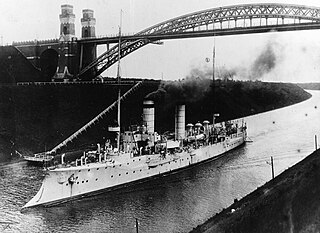
SMS Arcona was the ninth member of the ten-ship Gazelle class of light cruisers that were built for the German Kaiserliche Marine in the late 1890s and early 1900s. The Gazelle class was the culmination of earlier unprotected cruiser and aviso designs, combining the best aspects of both types in what became the progenitor of all future light cruisers of the Imperial fleet. Built to be able to serve with the main German fleet and as a colonial cruiser, she was armed with a battery of ten 10.5 cm (4.1 in) guns and a top speed of 21.5 knots. Arcona was a modified version of the basic Gazelle design, with improved armor and additional coal storage for a longer cruising range.

SMS Undine was the last member of the ten-ship Gazelle class of light cruisers that were built for the German Kaiserliche Marine in the late 1890s and early 1900s. The Gazelle class was the culmination of earlier unprotected cruiser and aviso designs, combining the best aspects of both types in what became the progenitor of all future light cruisers of the Imperial fleet. Built to be able to serve with the main German fleet and as a colonial cruiser, she was armed with a battery of ten 10.5 cm (4.1 in) guns and had a top speed of 21.5 knots. Undine was a modified version of the basic Gazelle design, with improved armor and additional coal storage for a longer cruising range.

The Siegfried class was a group of six coastal defense ships built by the German Kaiserliche Marine in the late 19th century. The ships were intended to protect the German coastline from naval attacks. The class comprised the lead ship Siegfried, along with her sisters Beowulf, Frithjof, Heimdall, Hildebrand, and Hagen. All six ships were named after Norse mythological figures. Two further vessels, the Odin class, were built to a similar design but were not identical.

SMS Beowulf was the second vessel of the six-member Siegfried class of coastal defense ships built for the German Imperial Navy. Her sister ships were Siegfried, Frithjof, Heimdall, Hildebrand, and Hagen. Beowulf was built by the AG Weser shipyard between 1890 and 1892, and was armed with a main battery of three 24-centimeter (9.4 in) guns. She served in the German fleet throughout the 1890s and was rebuilt in 1900 – 1902. She served in the VI Battle Squadron after the outbreak of World War I in August 1914, but saw no action. Beowulf was demobilized in 1915 and used as a target ship for U-boats thereafter. She was ultimately broken up for scrap in 1921.
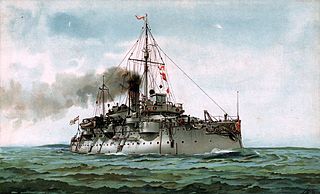
SMS Frithjof was the third vessel of the six-member Siegfried class of coastal defense ships built for the German Imperial Navy. Her sister ships were Siegfried, Beowulf, Heimdall, Hildebrand, and Hagen. Frithjof was built by the AG Weser shipyard between 1890 and 1893, and was armed with a main battery of three 24-centimeter (9.4 in) guns. She served in the German fleet throughout the 1890s and was rebuilt in 1900 - 1902. She served in the VI Battle Squadron after the outbreak of World War I in August 1914, but saw no action. Frithjof was demobilized in 1915 and used as a barracks ship thereafter. She was rebuilt as a merchant ship in 1923 and served in this capacity until she was broken up for scrap in 1930.

SMS Hildebrand was the fifth vessel of the six-member Siegfried class of coastal defense ships built for the German Imperial Navy. Her sister ships were Siegfried, Beowulf, Frithjof, Heimdall, and Hagen. Hildebrand was built by the Kaiserliche Werft at Kiel between 1890 and 1893, and was armed with a main battery of three 24-centimeter (9.4 in) guns. She served in the German fleet throughout the 1890s and was rebuilt in 1900–1902. She served in the VI Battle Squadron after the outbreak of World War I in August 1914, but saw no action. Hildebrand was demobilized in 1915 and used as a barracks ship thereafter. She ran aground while en route to the Netherlands for scrapping in 1919, and was eventually broken up in situ in 1933.
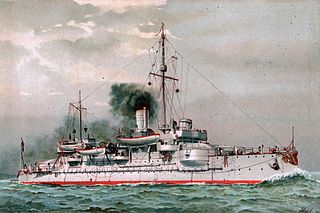
SMS Hagen was the final vessel of the six-member Siegfried class of coastal defense ships built for the German Imperial Navy. Her sister ships were Siegfried, Beowulf, Frithjof, Heimdall, and Hildebrand. Hagen was built by the Kaiserliche Werft in Kiel between 1891 and 1893, and was armed with a main battery of three 24-centimeter (9.4 in) guns. She served in the German fleet throughout the 1890s and was rebuilt in 1900 - 1902. She served in the VI Battle Squadron after the outbreak of World War I in August 1914, but saw no action. Hagen was demobilized in 1915 and used as a barracks ship thereafter. She was ultimately sold for scrap in 1919 and subsequently dismantled.

SMS Odin was the lead ship of her class of coastal defense ships built for the Imperial German Navy. She had one sister ship, Ägir. Odin, named for the eponymous Norse god, was built by the Kaiserliche Werft in Danzig between 1893 and 1896, and was armed with a main battery of three 24-centimeter (9.4 in) guns. She served in the German fleet throughout the 1890s and was rebuilt in 1901–1903. She served in the VI Battle Squadron after the outbreak of World War I in August 1914, but saw no action. Odin was demobilized in 1915 and used as a tender thereafter. After the war, she was rebuilt as a merchant ship and served in this capacity until 1935, when she was broken up for scrap.
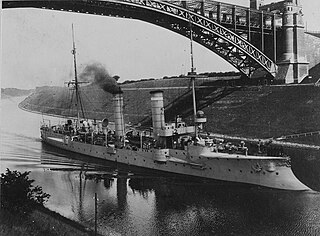
SMS Medusa was a member of the ten-ship Gazelle class of light cruisers that were built for the German Kaiserliche Marine in the late 1890s and early 1900s. The Gazelle class was the culmination of earlier unprotected cruiser and aviso designs, combining the best aspects of both types in what became the progenitor of all future light cruisers of the Imperial fleet. Built to be able to serve with the main German fleet and as a colonial cruiser, she was armed with a battery of ten 10.5 cm (4.1 in) guns and a top speed of 21.5 knots. Medusa served in all three German navies—the Kaiserliche Marine, the Reichsmarine of Weimar Germany, and the Kriegsmarine of Nazi Germany—over the span of over forty years.

SMS Amazone was the sixth member of the ten-ship Gazelle class of light cruisers that were built for the German Kaiserliche Marine in the late 1890s and early 1900s. The Gazelle class was the culmination of earlier unprotected cruiser and aviso designs, combining the best aspects of both types in what became the progenitor of all future light cruisers of the Imperial fleet. Built to be able to serve with the main German fleet and as a colonial cruiser, she was armed with a battery of ten 10.5 cm (4.1 in) guns and a top speed of 21.5 knots.
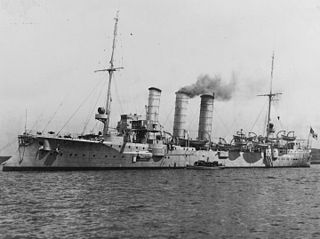
SMS München was the fifth of seven Bremen-class cruisers of the Imperial German Navy, named after the city of Munich. She was built by AG Weser in Bremen, starting in 1903, launched in April 1904, and commissioned in January 1905. Armed with a main battery of ten 10.5 cm (4.1 in) guns and two 45 cm (18 in) torpedo tubes, München was capable of a top speed of 22.5 knots.

SMS Blitz was an aviso of the German Kaiserliche Marine built in the early 1880s. She was the lead ship of her class, which included one other vessel, SMS Pfeil. Her primary offensive armament consisted of a bow-mounted torpedo tube, and she was armed with a battery of light guns to defend herself against torpedo boats, a sign of the growing importance of torpedoes as effective weapons in the period. The Blitz class featured a number of innovations in German warship design: they were the first steel hulled warships and the first cruiser-type ships to discard traditional sailing rigs.
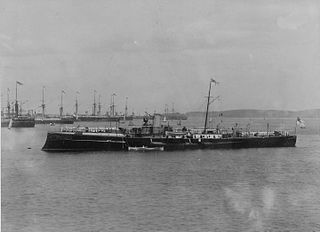
The Wacht class was a pair of avisos built by the German Kaiserliche Marine in the late-1880s; the class comprised two ships, Wacht and Jagd. They were laid down in 1886 and 1887 and completed by 1888 and 1889, respectively. The ships were based on the previous aviso, SMS Greif, which had proved to be an unsuccessful design due to its lack of torpedo armament. As a result, the Wacht-class ships were equipped with three torpedo tubes to improve their combat power; they were also the first German avisos to carry armor protection.

SMS Wacht was an aviso of the Imperial German Navy, the lead ship of her class. She had one sister ship, Jagd. Wacht was built by the AG Weser shipyard; she was laid down in 1886, launched in August 1887, and commissioned in August 1888. She served in the active fleet through the 1890s and participated in numerous training exercises. Her career was cut short on 4 September 1901, when she collided with the old ironclad SMS Sachsen. The latter's ram bow holed Wacht under the waterline and caused her to rapidly sink. Her crew was safely rescued, however, and there were no casualties.

SMS Jagd was an aviso of the Imperial German Navy, the second and final member of the Wacht class. She had one sister ship, Wacht. Jagd was laid down in 1887 at the AG Weser shipyard, launched in July 1888, and commissioned in June 1889. She served in the German fleet for the next fifteen years, until she was withdrawn from active duty in 1904. Thereafter, she was used as a harbor ship. In 1910, she was stricken from the naval register and hulked. She was later used as a torpedo training platform until 1920, when she was sold for scrapping.

SMS Mars was an artillery training ship of the German Kaiserliche Marine, built in the late 1870s.

SMS Mücke was an ironclad gunboat of the Wespe class built for the German Kaiserliche Marine in the 1870s. The ships, which were armed with a single 30.5 cm (12 in) MRK L/22 gun, were intended to serve as part of a coastal defense fleet.

SMS Bremse was the second and final member of the Brummer class of armored gunboats built for the German Kaiserliche Marine in the 1880s. The ship was ordered to serve in Germany's coastal defense system alongside the Sachsen-class ironclads and Wespe-class gunboats. They were significantly less well armed and protected compared to the Wespes, but they were lighter and faster vessels. Bremse's primary armament was a single 21 cm (8.3 in) gun carried in her bow, and she had a top speed of about 15 knots.






















